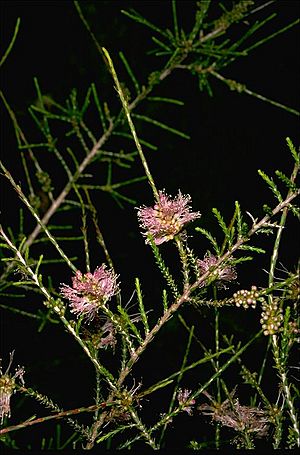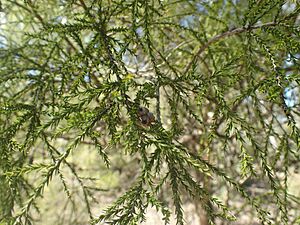Melaleuca pallescens facts for kids
Melaleuca pallescens is a cool plant from the Myrtaceae family, which also includes eucalyptus trees! It only grows naturally in Queensland, Australia. This plant has tough, bumpy bark and tiny leaves. These leaves are special because the bottom part of their top surface lies flat against the plant's branches.
Quick facts for kids Melaleuca pallescens |
|
|---|---|
 |
|
| Scientific classification | |
| Genus: |
Melaleuca
|
| Species: |
pallescens
|
| Synonyms | |
|
Melaleuca tamariscina subsp. pallescens (Byrnes) Barlow |
|

Contents
What Does Melaleuca pallescens Look Like?
Melaleuca pallescens can be a bushy shrub or a small tree. It usually grows up to about 4 meters (13 feet) tall. Its leaves are very small. They are only about 1.3 to 5.5 millimeters long. That's less than a quarter of an inch! The leaves are also very narrow, about 0.7 to 1.2 millimeters wide. They are smooth, meaning they have no hairs. Each leaf is shaped like a narrow egg and has a sharp point at its end.
Flowers and Fruit
The flowers of Melaleuca pallescens grow in spikes. These spikes are found at the ends of branches. Sometimes, they grow where a leaf meets the stem. Each spike has 3 to 12 groups of flowers, with three flowers in each group. The spikes can be up to 18 millimeters (about 0.7 inches) wide. They are also about 15 to 20 millimeters (0.6 to 0.8 inches) long.
When the flowers first open, they are pink or purple. But they quickly change color to white. The petals are a darker shade of pink or purple. They are about 1.5 to 1.6 millimeters long. These petals fall off as the flower gets older. Inside the flowers, there are five groups of stamens. Stamens are the parts that make pollen. Each group has 5 to 9 stamens.
The main time for flowering is in spring. After the flowers, the plant grows fruit. These fruits are woody capsules. They are about 2.5 to 4 millimeters long. You can find them scattered along the branches.
Where Does This Plant Get Its Name?
The plant Melaleuca pallescens was first officially described in 1984. A botanist named Norman Byrnes gave it its name. He wrote about it in a scientific paper called Austrobaileya.
The second part of its name, pallescens, comes from a Latin word. It means "ashen" or "wan," which describes a pale color. The ending -escens means "becoming." So, pallescens means "becoming ashen." This name refers to how the flowers quickly fade to a pale white color.
Where Does Melaleuca pallescens Grow?
Melaleuca pallescens is found in the eastern part of Queensland, Australia. It likes to grow in heavy clay soils. You can often find it near streams and other wet areas.

